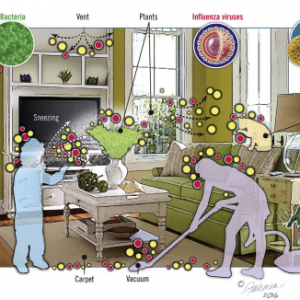This is Kent Duffy talking about the influences of microbial research on architectural practice. This was recorded at the MoBE 2017 symposium in Washington D.C. If you’re interested, check out all of the other speakers from MoBE 2017 on our YouTube channel!
Microbes indoors Effects of Microbial Aerosol in Poultry House on Meat Ducks’ Immune Function – Guanliu Yu – Frontiers in Microbiology (OA) The aim of this study was to evaluate effects of microbial aerosols on immune function of ducks and shed light on the establishment of microbial aerosol concentration standards for poultry. A total of 1800 …
This last winter, Gwynne Mhuireach at the University of Oregon taught a really interesting course entitled “Human Health and the Design of the Urban Microbiome”. She posted a description of the final “design charrette” here on microBEnet awhile back. I just asked her if she’d be willing to share her course materials for others interested …
The title of this commentary in Microbiome, “Making microbiology of the built environment relevant to design” gets right to the heart of one of the long-standing issues in the field. Thanks in no small part to the Sloan Foundation program in the Microbiology of the Built Environment, as well as technological changes in DNA sequencing… …
By Amanda Makowiecki 1st Year Mechanical Engineering PhD Student Miller Research Group, University of Colorado Boulder Researchers at the University of Oregon recently published a paper examining the connection between architectural design and microbial diversity in our buildings (Kembel et al. 2014). Although occupancy type was identified as the strongest predictor of microbial variation, several …
The University of Oregon’s Biology and the Built Environment Center has been chosen by the American Institute of Architects (AIA), the AIA Foundation, and the Association of Collegiate Schools of Architecture to be a charter member of the AIA Design & Health Research Consortium. The eleven Consortium members are university-led teams of architecture and public …
I am starting to think a lot about the connections between architecture and microbiology – in part in preparation for the American Institute for Architects Annual Meeting in Atlanta May 14-16 where I will be participating in sessions on “microbes in the built environment” The tentative details for the sessions are Session: Microbes in the Built Environment: Perspectives …
Bill Walsh of The Healthy Building Network has posted a story on the subject,”the Dirt on Antimicrobials” that covers the health effects concerns from the chemicals themselves but does not address the currently popular subject of the health harm or benefits from the presence of and exposures to the multitude of microbes in, on, and …
Last week, Holly Ganz from microBEnet organized a workshop on “Animals in the Built Environment”, focusing on the intersections between animal care, building design, and microbial ecology. Participants included zoo staff, shelter architects, engineers, microbial ecologists, etc. More detailed meeting reports will follow, but as a teaser here is the Storify from the meeting:
Guest Blog Post by Dr. Nick Clements, PhD Post-doctoral Researcher, University of Colorado Boulder, Miller Research Group In the event of a disaster, hospitals must have plans in place for receiving a surge of patients with a variety of possible infectious diseases or conditions. Pandemic-causing infectious diseases, such as the viruses that caused the SARS …

